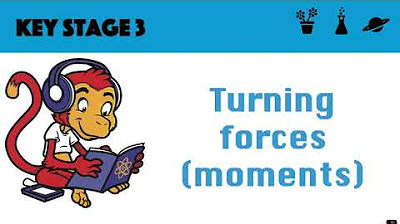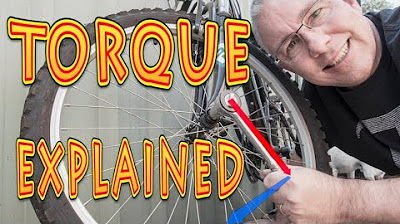Moment of a Force | Mechanics Statics | (Learn to solve any question)
TLDRThis script explains the concept of torque, or moment, in mechanics. It describes how a force applied at a distance creates a turning effect around an axis. The importance of the perpendicular distance and the line of action in calculating moments is emphasized. The script also covers how to find the moment in 2D and 3D problems, using the right-hand rule and cross product, respectively. Practical examples are provided to illustrate the calculation of moments and resultant moments for various force configurations.
Takeaways
- 🔧 Torque, or moment, is created when a force is applied to turn an object about an axis or specific point.
- 📐 The magnitude of the moment is the product of the force applied and the perpendicular distance from the axis of rotation.
- 🖌️ When the force is applied directly along the axis of rotation, no moment is created, as the line of action intersects the axis.
- 🔄 The moment vector's direction can be determined using the right-hand rule, with clockwise moments being positive and counterclockwise moments being negative.
- 📊 In 2D problems, moments are calculated by multiplying the force components perpendicular to the axis of rotation by their respective distances from the axis.
- ⚙️ For 3D problems, the cross product of the force vector and the position vector is used to calculate the moment.
- 📍 The position vector for the cross product can be from the point of interest to any location along the line of action of the force.
- 🔢 The unit of moment is Newton meters (Nm), which represents the product of force in Newtons and distance in meters.
- 📈 To find the resultant moment, calculate the individual moments and sum them up, considering their directions.
- 🔧 When solving problems, it's important to express forces in Cartesian form and understand how to calculate position vectors and cross products.
- 📚 Examples and practice problems are crucial for understanding the concepts of moments and applying them in various scenarios.
Q & A
What is the definition of torque?
-Torque is the tendency of a force to cause or prevent the rotation of an object about an axis or a specific point.
How is the magnitude of a moment calculated?
-The magnitude of a moment is calculated by multiplying the force applied by the perpendicular distance from the axis of rotation to the line of action of the force.
What happens when a force is applied directly along the handle of a wrench?
-When a force is applied directly along the handle of a wrench, no rotation occurs because the line of action of the force intersects the axis of rotation, meaning it cannot create a moment.
How can you find the moment vector using the right-hand rule?
-To find the moment vector using the right-hand rule, apply a force in a counterclockwise direction, and the moment vector will point straight upwards along the z-axis.
What are the units of moment magnitude?
-The units of moment magnitude are Newton meters (N·m), which is the product of force in Newtons (N) and distance in meters (m).
How do you find the resultant moment when multiple forces are acting?
-To find the resultant moment, calculate the individual moments created by each force and then sum them up.
What is the cross product used for in calculating moments in 3 dimensions?
-The cross product is used to find the moment in 3 dimensions by taking the cross product between the force vector and a position vector from the point where the moment is being calculated to a point along the line of action of the force.
How do you determine the direction of rotation when calculating moments?
-The direction of rotation can be determined by visualizing the object rotating about the point of interest. If the force applied causes a clockwise rotation, it is considered positive; counterclockwise rotation is considered negative.
In the 2D moment problem, why can the x components of forces F1 and F2 be ignored?
-The x components of forces F1 and F2 can be ignored because they pass through the line of action, meaning they do not create a moment and will not cause the object to rotate about point A.
How do you express a force in Cartesian form?
-To express a force in Cartesian form, you need to break it down into its x, y, and z components. This requires knowledge of the force's magnitude and direction and the ability to perform vector decomposition.
What is the significance of the position vector in calculating moments?
-The position vector is crucial in calculating moments because it defines the direction and distance from the point of interest to the point where the force is applied. This vector is used in the calculation of the moment through the cross product in 3D problems.
How do you calculate the resultant moment created by two forces acting on a flagpole?
-To calculate the resultant moment created by two forces on a flagpole, first express each force in Cartesian form using the magnitude and unit vector. Then, calculate the cross product for each force with the corresponding position vector from the axis of rotation to the point where the force is applied. Finally, add the resulting moment vectors together to find the resultant moment.
Outlines
🔧 Understanding Moments and Torque
This paragraph introduces the concept of moments, often referred to as torque. It explains moments as the rotational equivalent of force, created when a force is applied to turn an object about an axis or specific point. The explanation uses the analogy of a wrench being applied to demonstrate how the moment is calculated as the product of the force and the perpendicular distance from the axis. It also discusses the line of action and how it affects the creation of moments. The paragraph further explains how to calculate moments in two dimensions by multiplying the force by its respective perpendicular distance and touches on the concept of resultant moments when multiple forces are involved. It concludes by introducing the cross product method for calculating moments in three dimensions and encourages viewers to review related content for a deeper understanding.
📐 Calculating Moments in 2D and 3D Problems
This paragraph delves into the practical application of calculating moments in both two and three dimensions. It begins with a 2D problem, illustrating how to find the moment each of three forces creates about a specific point by breaking down the forces into their x and y components and then calculating the moment as the product of the force and the perpendicular distance. The paragraph emphasizes the importance of considering only components perpendicular to the axis of rotation and the direction of rotation caused by the moment. It then transitions to a 3D problem, explaining the process of using the cross product between the force and a position vector to find the moment about a point. The paragraph provides a step-by-step guide on expressing forces in cartesian form, calculating the magnitude and unit vectors, and finally performing the cross product to find the moment. The summary concludes with examples of calculating resultant moments caused by multiple forces acting on a structure, such as a flagpole, and reiterates the importance of correctly summing the components of the moments.
Mindmap
Keywords
💡Moment
💡Torque
💡Axis of Rotation
💡Line of Action
💡Components of Force
💡Right-Hand Rule
💡Cross Product
💡Cartesian Form
💡Resultant Moment
💡Position Vector
Highlights
Torque is the moment created when a force is applied to turn an object about an axis or specific point.
The magnitude of the moment is the force applied multiplied by the perpendicular distance from the axis.
When a force is applied directly along the handle (line of action), no rotation occurs, hence no moment is created.
The moment vector can be determined using the right-hand rule, indicating the direction of rotation.
In 2D problems, moments are calculated by multiplying the forces by their respective perpendicular distances.
For multiple forces, the resultant moment is found by summing the individual moments created by each force.
In 3D problems, moments are calculated using the cross product between the force and a position vector.
The force must be expressed in Cartesian form to use the cross product for calculating moments in 3D.
The direction of the moment (clockwise or counterclockwise) affects whether the moment is considered positive or negative.
To find the resultant moment of forces acting on a structure, express each force in Cartesian form and take the cross product with the appropriate position vectors.
For a bent rod or irregular shapes, use the cross product of the force and position vector to find the moment about a point.
When calculating moments in the x, y, and z plane, the position vector from the point of interest to where the force ends is crucial.
The resultant moment of multiple forces is the sum of the individual moments, combining their respective I, J, and K components.
The choice of position vector for calculating moments can vary, but the result will remain consistent as long as it's along the line of action of the force.
Understanding and calculating moments is essential for analyzing the rotational effects of forces on objects.
The video provides step-by-step examples to clarify the concepts of calculating moments in both 2D and 3D scenarios.
Transcripts
5.0 / 5 (0 votes)
Thanks for rating:





